Deck 8: Torque and Angular Momentum
Question
Question
Question
Question
Question
Question
Question
Question
Question
Question
Question
Question
Question
Question
Question
Question
Question
Question
Question
Question
Question
Question
Question
Question
Question
Question
Question
Question
Question
Question
Question
Question
Question
Question
Question
Question
Question
Question
Question
Question
Question
Question
Question
Question
Question
Question
Question
Question
Question
Question
Question
Question
Question
Question
Question
Question
Question
Question
Question
Question
Question
Question
Question
Question
Question
Question
Question
Question
Question
Question
Question
Question
Question
Question
Question
Question
Question
Question
Question
Question

Unlock Deck
Sign up to unlock the cards in this deck!
Unlock Deck
Unlock Deck
1/91
Play
Full screen (f)
Deck 8: Torque and Angular Momentum
1
A centrifuge has a rotational inertia of 5.50 × 10−3 kg m2. How much energy must be supplied to bring it from rest to 500 rad/s?
A) 627 J
B) 570 J
C) 688 J
D) 743 J
E) 583 J
A) 627 J
B) 570 J
C) 688 J
D) 743 J
E) 583 J
688 J
2
The rotational inertia of a thin rod about one end is 1/3 ML2. What is the rotational inertia of the same rod about a point located 0.300 L from the end?
A) 0.123 ML2
B) 0.198 ML2
C) 0.205 ML2
D) 0.240 ML2
E) 0.300 ML2
A) 0.123 ML2
B) 0.198 ML2
C) 0.205 ML2
D) 0.240 ML2
E) 0.300 ML2
0.123 ML2
3
A 5.00 kg mass is located at (2.00 m, 0.00 m, 0.00 m) and a 3.00 kg mass is located at (0.00 m, 4.00 m, 0.00 m). The center of gravity of the system of masses is
A) (1.25 m, 1.25 m, 0).
B) (1.50 m, 1.50 m, 0).
C) (1.25 m, 1.50 m, 0).
D) (1.50 m, 1.25 m, 0).
E) (1.00 m, 1.00 m, 0).
A) (1.25 m, 1.25 m, 0).
B) (1.50 m, 1.50 m, 0).
C) (1.25 m, 1.50 m, 0).
D) (1.50 m, 1.25 m, 0).
E) (1.00 m, 1.00 m, 0).
(1.25 m, 1.50 m, 0).
4
A 4.00 kg mass is located at (2.00 m, 2.00 m, 0.00 m) and a 3.00 kg mass is located at (−1.0 m, 3.00 m, 0.00 m). The rotational inertia of this system of masses about the X-axis, perpendicular to the Z-Y plane, is
A) 24 kg m2.
B) 36 kg m2.
C) 43 kg m2.
D) 56 kg m2.
E) 62 kg m2.
A) 24 kg m2.
B) 36 kg m2.
C) 43 kg m2.
D) 56 kg m2.
E) 62 kg m2.

Unlock Deck
Unlock for access to all 91 flashcards in this deck.
Unlock Deck
k this deck
5
The rotational inertia of a thin rod about one end is 1/3 ML2. What is the rotational inertia of the same rod about a point located 0.40 L from the end?
A) 0.493 ML2
B) 0.243 ML2
C) 0.093 ML2
D) 0.073 ML2
E) 0.056 ML2
A) 0.493 ML2
B) 0.243 ML2
C) 0.093 ML2
D) 0.073 ML2
E) 0.056 ML2

Unlock Deck
Unlock for access to all 91 flashcards in this deck.
Unlock Deck
k this deck
6
A torque of 15.0 N.m is applied to a bolt. The bolt rotates through an angle of 360 degrees. The work done in turning the bolt is
A) 94.2 J.
B) 91.3 J.
C) 96.7 J.
D) 89.9 J.
E) 98.1 J.
A) 94.2 J.
B) 91.3 J.
C) 96.7 J.
D) 89.9 J.
E) 98.1 J.

Unlock Deck
Unlock for access to all 91 flashcards in this deck.
Unlock Deck
k this deck
7
A 2.00 kg mass is located at (4.00 m, 0.00 m, 0.00 m) and a 4.00 kg mass is located at (0.00 m, 3.00 m, 0.00 m). The center of gravity of the system of masses is
A) (1.33 m, 2.00 m, 0).
B) (1.33 m, 1.00 m, 0).
C) (1.50 m, 1.33 m, 0).
D) (2.00 m, 1.33 m, 0).
E) (1.33 m, 1.50 m, 0).
A) (1.33 m, 2.00 m, 0).
B) (1.33 m, 1.00 m, 0).
C) (1.50 m, 1.33 m, 0).
D) (2.00 m, 1.33 m, 0).
E) (1.33 m, 1.50 m, 0).

Unlock Deck
Unlock for access to all 91 flashcards in this deck.
Unlock Deck
k this deck
8
A 30.0 cm wrench is used to generate a torque at a bolt. A force of 50.0 N is applied at the end of the wrench at an angle of 70.0 degrees. The torque generated at the bolt is
A) 10.4 N·m.
B) 14.1 N·m.
C) 19.7 N·m.
D) 21.5 N·m.
E) 26.2 N·m.
A) 10.4 N·m.
B) 14.1 N·m.
C) 19.7 N·m.
D) 21.5 N·m.
E) 26.2 N·m.

Unlock Deck
Unlock for access to all 91 flashcards in this deck.
Unlock Deck
k this deck
9
A 30.0 cm wrench is used to generate a torque at a bolt. A force of 40 N is applied perpendicularly at the end of the wrench. The torque generated at the bolt is
A) 5.0 N·m.
B) 7.0 N·m.
C) 9.0 N·m.
D) 12 N·m.
E) 20 N·m.
A) 5.0 N·m.
B) 7.0 N·m.
C) 9.0 N·m.
D) 12 N·m.
E) 20 N·m.

Unlock Deck
Unlock for access to all 91 flashcards in this deck.
Unlock Deck
k this deck
10
A 6.00 kg mass is located at (2.00 m, 2.00 m, 2.00 m) and a 5.00 kg mass is located at (−1.0 m, 3.00 m, −2.00 m). The rotational inertia of this system of masses about the X-axis, perpendicular to the Z-Y plane, is
A) 281 kg m2.
B) 167 kg m2.
C) 113 kg m2.
D) 85 kg m2.
E) 69 kg m2.
A) 281 kg m2.
B) 167 kg m2.
C) 113 kg m2.
D) 85 kg m2.
E) 69 kg m2.

Unlock Deck
Unlock for access to all 91 flashcards in this deck.
Unlock Deck
k this deck
11
A 2.00 kg mass is located at (4.00 m, 0.00 m, 0.00 m) and a 4.00 kg mass is located at (0.00 m, 3.00 m, 0.00 m). The rotational inertia of this system of masses about the X-axis, perpendicular to the Z-Y plane, is
A) 23 kg m2.
B) 28 kg m2.
C) 33 kg m2.
D) 36 kg m2.
E) 41 kg m2.
A) 23 kg m2.
B) 28 kg m2.
C) 33 kg m2.
D) 36 kg m2.
E) 41 kg m2.

Unlock Deck
Unlock for access to all 91 flashcards in this deck.
Unlock Deck
k this deck
12
What is the rotational inertia of a solid iron disk of mass 41.0 kg with a thickness of 5.00 cm and radius of 30.0 cm, about an axis perpendicular to the disk and passing through its center?
A) 0.980 kg m2
B) 0.761 kg m2
C) 1.85 kg m2
D) 2.29 kg m2
A) 0.980 kg m2
B) 0.761 kg m2
C) 1.85 kg m2
D) 2.29 kg m2

Unlock Deck
Unlock for access to all 91 flashcards in this deck.
Unlock Deck
k this deck
13
A 20.0 cm wrench is used to generate a torque at a bolt. A force of 50 N is applied perpendicularly at the end of the wrench. The torque generated at the bolt is
A) 8.0 N·m.
B) 10 N·m.
C) 14 N·m.
D) 22 N·m.
E) 37 N·m.
A) 8.0 N·m.
B) 10 N·m.
C) 14 N·m.
D) 22 N·m.
E) 37 N·m.

Unlock Deck
Unlock for access to all 91 flashcards in this deck.
Unlock Deck
k this deck
14
A torque of 20.0 N·m is applied to a bolt. The bolt rotates through an angle of 180 degrees. The work done in turning the bolt is
A) 72.5 J.
B) 51.9 J.
C) 62.8 J.
D) 49.9 J.
E) 58.4 J.
A) 72.5 J.
B) 51.9 J.
C) 62.8 J.
D) 49.9 J.
E) 58.4 J.

Unlock Deck
Unlock for access to all 91 flashcards in this deck.
Unlock Deck
k this deck
15
A 6.00 kg mass is located at (2.00 m, 2.00 m, 2.00 m) and a 5.00 kg mass is located at (−1.0 m, 3.00 m, −2.00 m). The rotational inertia of this system of masses about the Y-axis, perpendicular to the Z-X plane, is
A) 73 kg m2.
B) 66 kg m2.
C) 60 kg m2.
D) 55 kg m2.
E) 48 kg m2.
A) 73 kg m2.
B) 66 kg m2.
C) 60 kg m2.
D) 55 kg m2.
E) 48 kg m2.

Unlock Deck
Unlock for access to all 91 flashcards in this deck.
Unlock Deck
k this deck
16
A 6.00 kg mass is located at (2.00 m, 2.00 m, 2.00 m) and a 5.00 kg mass is located at (−1.0 m, 3.00 m, −2.00 m). The rotational inertia of this system of masses about the Z-axis, perpendicular to the X-Y plane, is
A) 60 kg m2.
B) 79 kg m2.
C) 85 kg m2.
D) 98 kg m2.
E) 112 kg m2.
A) 60 kg m2.
B) 79 kg m2.
C) 85 kg m2.
D) 98 kg m2.
E) 112 kg m2.

Unlock Deck
Unlock for access to all 91 flashcards in this deck.
Unlock Deck
k this deck
17
A 4.00 kg mass is located at (2.00 m, 2.00 m, 0.00 m) and a 3.00 kg mass is located at (−1 m, 3.00 m, 0.00 m). The rotational inertia of this system of masses about the Y-axis, perpendicular to the X-Z plane, is
A) 40 kg m2.
B) 32 kg m2.
C) 29 kg m2.
D) 24 kg m2.
E) 19 kg m2.
A) 40 kg m2.
B) 32 kg m2.
C) 29 kg m2.
D) 24 kg m2.
E) 19 kg m2.

Unlock Deck
Unlock for access to all 91 flashcards in this deck.
Unlock Deck
k this deck
18
A 5.00 kg mass is located at (2.00 m, 0.00 m, 3.00 m) and a 2.00 kg mass is located at (0.00 m, 4.00 m, -2.00 m). The center of gravity of the system of masses is
A) (10/7 m, 8/7 m, 11/7 m).
B) (11/7 m, 7/7 m, 8/7 m).
C) (7/7 m, 10/7 m, 11/7 m).
D) (10/7 m, 7/7 m, 8/7 m).
E) (8/7 m, 7/7 m, 10/7 m).
A) (10/7 m, 8/7 m, 11/7 m).
B) (11/7 m, 7/7 m, 8/7 m).
C) (7/7 m, 10/7 m, 11/7 m).
D) (10/7 m, 7/7 m, 8/7 m).
E) (8/7 m, 7/7 m, 10/7 m).

Unlock Deck
Unlock for access to all 91 flashcards in this deck.
Unlock Deck
k this deck
19
A 2.00 kg mass is located at (4.00 m, 0.00 m, 0.00 m) and a 4.00 kg mass is located at (0.00 m, 3.00 m, 0.00 m). The rotational inertia of this system of masses about the Z-axis, perpendicular to the X-Y plane, is
A) 50 kg m2.
B) 55 kg m2.
C) 58 kg m2.
D) 62 kg m2.
E) 68 kg m2.
A) 50 kg m2.
B) 55 kg m2.
C) 58 kg m2.
D) 62 kg m2.
E) 68 kg m2.

Unlock Deck
Unlock for access to all 91 flashcards in this deck.
Unlock Deck
k this deck
20
A 20.0 cm wrench is used to generate a torque at a bolt. A force of 50 N is applied at the end of the wrench at an angle of 60.0 degrees to the wrench. The torque generated at the bolt is
A) 4.9 N·m.
B) 5.7 N·m.
C) 6.0 N·m.
D) 7.5 N·m.
E) 8.7 N·m.
A) 4.9 N·m.
B) 5.7 N·m.
C) 6.0 N·m.
D) 7.5 N·m.
E) 8.7 N·m.

Unlock Deck
Unlock for access to all 91 flashcards in this deck.
Unlock Deck
k this deck
21
A 75.0 kg ladder that is 3.00 m long is placed against a wall at an angle theta. The center of gravity of the ladder is at a point 1.2 m from the base of the ladder. The coefficient of static friction at the base of the ladder is 0.400. There is no friction between the wall and the ladder. What is the minimum angle the ladder must make with the horizontal for the ladder not to slip and fall? 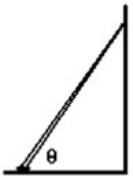
A) 35 degrees
B) 45 degrees
C) 53 degrees
D) 60 degrees
E) 65 degrees

A) 35 degrees
B) 45 degrees
C) 53 degrees
D) 60 degrees
E) 65 degrees

Unlock Deck
Unlock for access to all 91 flashcards in this deck.
Unlock Deck
k this deck
22
A 75.0 kg ladder that is 3.00 m long is placed against a wall at an angle theta. The center of gravity of the ladder is at a point 1.20 m from the base of the ladder. The coefficient of static friction at the base of the ladder is 0.800. There is no friction between the wall and the ladder. What is the minimum angle the ladder must make with the horizontal for the ladder not to slip and fall? 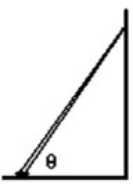
A) 26.57 degrees
B) 30.34 degrees
C) 36.35 degrees
D) 40.55 degrees
E) 46.52 degrees

A) 26.57 degrees
B) 30.34 degrees
C) 36.35 degrees
D) 40.55 degrees
E) 46.52 degrees

Unlock Deck
Unlock for access to all 91 flashcards in this deck.
Unlock Deck
k this deck
23
A 75.0 kg ladder that is 3.00 m long is placed against a wall at an angle theta. The center of gravity of the ladder is at a point 1.20 m from the base of the ladder. The coefficient of static friction at the base of the ladder is 0.800. There is no friction between the wall and the ladder. What is the vertical force of the ground on the ladder? 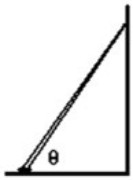
A) 625 N
B) 640 N
C) 735 N
D) 832 N
E) 900 N

A) 625 N
B) 640 N
C) 735 N
D) 832 N
E) 900 N

Unlock Deck
Unlock for access to all 91 flashcards in this deck.
Unlock Deck
k this deck
24
A 1.500 m long uniform beam of mass 30.00 kg is supported by a wire as shown in the figure. The beam makes an angle of 10.00 degrees with the horizontal and the wire makes an angle of 30.00 degrees with the beam. A 50.00 kg mass, m, is attached to the end of the beam. What is the tension in the wire? 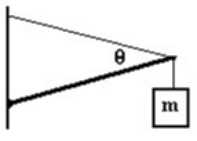
A) 2,034 N
B) 1,855 N
C) 1,435 N
D) 1,255 N
E) 1,035 N

A) 2,034 N
B) 1,855 N
C) 1,435 N
D) 1,255 N
E) 1,035 N

Unlock Deck
Unlock for access to all 91 flashcards in this deck.
Unlock Deck
k this deck
25
A 6.00 kg mass is located at (1.0 m, −2.00 m, 3.00 m), a 5.00 kg mass is located at (1.0 m, 3.00 m, −2.00 m), and a 4.00 kg mass is located at (−1.0 m, −2.00 m, 2.00 m). The center of gravity of the system of masses is
A) (5/15 m, −1/15 m, 17/15 m).
B) (5/15 m, −17/15 m, 5/15 m).
C) (12/15 m, −5/15 m, 16/15 m).
D) (7/15 m, −5/15 m, 16/15 m).
E) (16/15 m, −1/15 m, 17/15 m).
A) (5/15 m, −1/15 m, 17/15 m).
B) (5/15 m, −17/15 m, 5/15 m).
C) (12/15 m, −5/15 m, 16/15 m).
D) (7/15 m, −5/15 m, 16/15 m).
E) (16/15 m, −1/15 m, 17/15 m).

Unlock Deck
Unlock for access to all 91 flashcards in this deck.
Unlock Deck
k this deck
26
A 10 kg object has a moment of inertia of 1.25 kg m2. If a torque of 2.5 N•m is applied to the object, the angular acceleration is
A) 10 rad/s2.
B) 8.0 rad/s2.
C) 6.0 rad/s2.
D) 4.0 rad/s2.
E) 2.0 rad/s2.
A) 10 rad/s2.
B) 8.0 rad/s2.
C) 6.0 rad/s2.
D) 4.0 rad/s2.
E) 2.0 rad/s2.

Unlock Deck
Unlock for access to all 91 flashcards in this deck.
Unlock Deck
k this deck
27
A 1.500 m long uniform beam of mass 30.00 kg is supported by a wire as shown in the figure. The beam makes an angle of 10.00 degrees with the horizontal and the wire makes an angle of 30.00 degrees with the beam. A 50.00 kg mass, m, is attached to the end of the beam. What are the vertical and horizontal components of the force of the wall on the beam at the hinge? 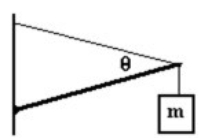
A) H = 1,458 N, V = 454.0 N
B) H = 1,300 N, V = 403.4 N
C) H = 1,179 N, V = 354.9 N
D) H = 979 N, V = 324.5 N
E) H = 750 N, V = 297.3 N

A) H = 1,458 N, V = 454.0 N
B) H = 1,300 N, V = 403.4 N
C) H = 1,179 N, V = 354.9 N
D) H = 979 N, V = 324.5 N
E) H = 750 N, V = 297.3 N

Unlock Deck
Unlock for access to all 91 flashcards in this deck.
Unlock Deck
k this deck
28
A 5.00 kg mass is located at (1.0 m, 0.00 m, 3.00 m), a 2.00 kg mass is located at (0.00 m, 3.00 m, −2.00 m), and a 3.00 kg mass is located at (−1.0 m , −2.00 m , 0.00 m). The center of gravity of the system of masses is
A) (1/10 m, 10/10 m, 1/10 m).
B) (2/10 m, 0 m, 11/10 m).
C) (3/10 m, 2/10 m, 10/10 m).
D) (10/10 m, 2/10 m, 3/10 m).
E) (2/10 m, 10/10 m, 0 m).
A) (1/10 m, 10/10 m, 1/10 m).
B) (2/10 m, 0 m, 11/10 m).
C) (3/10 m, 2/10 m, 10/10 m).
D) (10/10 m, 2/10 m, 3/10 m).
E) (2/10 m, 10/10 m, 0 m).

Unlock Deck
Unlock for access to all 91 flashcards in this deck.
Unlock Deck
k this deck
29
Chris and Jamie are carrying Wayne on a horizontal stretcher. The uniform stretcher is 2.00 m long and weighs 100 N. Wayne weighs 800 N. Wayne's center of gravity is 75.0 cm from Chris. Chris and Jamie are at the ends of the stretcher. The upward force that Chris is exerting to support the stretcher, with Wayne on it, is
A) 250 N.
B) 350 N.
C) 400 N.
D) 550 N.
E) 650 N.
A) 250 N.
B) 350 N.
C) 400 N.
D) 550 N.
E) 650 N.

Unlock Deck
Unlock for access to all 91 flashcards in this deck.
Unlock Deck
k this deck
30
An 8.00 kg object has a moment of inertia of 1.50 kg m2. If a torque of 2.00 N•m is applied to the object, the angular acceleration is
A) 0.750 rad/s2.
B) 1.00 rad/s2.
C) 1.33 rad/s2.
D) 2.01 rad/s2.
E) 2.67 rad/s2.
A) 0.750 rad/s2.
B) 1.00 rad/s2.
C) 1.33 rad/s2.
D) 2.01 rad/s2.
E) 2.67 rad/s2.

Unlock Deck
Unlock for access to all 91 flashcards in this deck.
Unlock Deck
k this deck
31
Chris and Jamie are carrying Wayne on a horizontal stretcher. The uniform stretcher is 2.00 m long and weighs 100 N. Wayne weighs 800 N. Wayne's center of gravity is 75.0 cm from Chris. Chris and Jamie are at the ends of the stretcher. The upward force that Jamie is exerting to support the stretcher, with Wayne on it, is
A) 250 N.
B) 300 N.
C) 350 N.
D) 400 N.
E) 550 N.
A) 250 N.
B) 300 N.
C) 350 N.
D) 400 N.
E) 550 N.

Unlock Deck
Unlock for access to all 91 flashcards in this deck.
Unlock Deck
k this deck
32
A 5.00 kg object has a moment of inertia of 1.20 kg m2. What torque is needed to give the object an angular acceleration of 2.0 rad/s2?
A) 2.4 N·m
B) 2.6 N·m
C) 2.8 N·m
D) 3.0 N·m
E) 3.2 N·m
A) 2.4 N·m
B) 2.6 N·m
C) 2.8 N·m
D) 3.0 N·m
E) 3.2 N·m

Unlock Deck
Unlock for access to all 91 flashcards in this deck.
Unlock Deck
k this deck
33
A 2.000 m long horizontal uniform beam of mass 20.00 kg is supported by a wire as shown in the figure. The wire makes an angle of 20.00 degrees with the beam. Attached to the beam 1.400 m from the wall is a ball with a mass of 40.00 kg. What are the vertical and horizontal components of the force of the wall on the beam at the hinge? 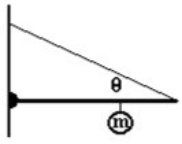
A) V = 175.6 N, H = 2,023 N
B) V = 186.6 N, H = 1,805 N
C) V = 195.4 N, H = 1,750 N
D) V = 200.6 N, H = 1,323 N
E) V = 215.6 N, H = 1,023 N

A) V = 175.6 N, H = 2,023 N
B) V = 186.6 N, H = 1,805 N
C) V = 195.4 N, H = 1,750 N
D) V = 200.6 N, H = 1,323 N
E) V = 215.6 N, H = 1,023 N

Unlock Deck
Unlock for access to all 91 flashcards in this deck.
Unlock Deck
k this deck
34
Jim and Mary are carrying Bob on a horizontal stretcher. The uniform stretcher is 2.00 m long and weighs 80 N. Bob weighs 600 N. Bob's center of gravity is 80 cm from Mary. Jim and Mary are at the ends of the stretcher. The upward force that Mary is exerting to support the stretcher, with Bob on it, is
A) 550 N.
B) 400 N.
C) 300 N.
D) 280 N.
E) 200 N.
A) 550 N.
B) 400 N.
C) 300 N.
D) 280 N.
E) 200 N.

Unlock Deck
Unlock for access to all 91 flashcards in this deck.
Unlock Deck
k this deck
35
A torque of 2.00 N•m is applied to a 10.0 kg object to give it an angular acceleration. If the angular acceleration is 1.75 rad/s2, then the moment of inertia is
A) 1.95 kg m2.
B) 1.05 kg m2.
C) 1.14 kg m2.
D) 1.20 kg m2.
E) 1.35 kg m2.
A) 1.95 kg m2.
B) 1.05 kg m2.
C) 1.14 kg m2.
D) 1.20 kg m2.
E) 1.35 kg m2.

Unlock Deck
Unlock for access to all 91 flashcards in this deck.
Unlock Deck
k this deck
36
A 2.00 m long horizontal uniform beam of mass 20.0 kg is supported by a wire as shown in the figure. The wire makes an angle of 20.0 degrees with the beam. Attached to the beam 1.40 m from the wall is a ball with a mass of 40.0 kg. What is the tension in the string? 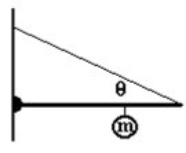
A) 1,000 N
B) 1,090 N
C) 2,100 N
D) 2,250 N
E) 2,680 N

A) 1,000 N
B) 1,090 N
C) 2,100 N
D) 2,250 N
E) 2,680 N

Unlock Deck
Unlock for access to all 91 flashcards in this deck.
Unlock Deck
k this deck
37
A 10 kg solid cylinder with a 50.0 cm radius has a moment of inertia of 1/2 MR2. If a torque of 2.0 N•m is applied to the object, the angular acceleration is
A) 1.0 rad/s2.
B) 1.6 rad/s2.
C) 1.8 rad/s2.
D) 2.1 rad/s2.
E) 2.3 rad/s2.
A) 1.0 rad/s2.
B) 1.6 rad/s2.
C) 1.8 rad/s2.
D) 2.1 rad/s2.
E) 2.3 rad/s2.

Unlock Deck
Unlock for access to all 91 flashcards in this deck.
Unlock Deck
k this deck
38
An 8.0 kg object has a moment of inertia of 1.00 kg m2. What torque is needed to give the object an angular acceleration of 1.5 rad/s2?
A) 3.0 N·m
B) 2.5 N·m
C) 2.0 N·m
D) 1.5 N·m
E) 1.0 N·m
A) 3.0 N·m
B) 2.5 N·m
C) 2.0 N·m
D) 1.5 N·m
E) 1.0 N·m

Unlock Deck
Unlock for access to all 91 flashcards in this deck.
Unlock Deck
k this deck
39
A 10 kg sphere with a 25.0 cm radius has a moment of inertia of 2/5 MR2. If a torque of 2.0 N•m is applied to the object, the angular acceleration is
A) 1.0 rad/s2.
B) 2.0 rad/s2.
C) 4.0 rad/s2.
D) 6.0 rad/s2.
E) 8.0 rad/s2.
A) 1.0 rad/s2.
B) 2.0 rad/s2.
C) 4.0 rad/s2.
D) 6.0 rad/s2.
E) 8.0 rad/s2.

Unlock Deck
Unlock for access to all 91 flashcards in this deck.
Unlock Deck
k this deck
40
Jim and Mary are carrying Bob on a horizontal stretcher. The uniform stretcher is 2.00 m long and weighs 80 N. Bob weighs 600 N. Bob's center of gravity is 80 cm from Mary. Jim and Mary are at the ends of the stretcher. The upward force that Jim is exerting to support the stretcher, with Bob on it, is
A) 280 N.
B) 320 N.
C) 380 N.
D) 400 N.
E) 520 N.
A) 280 N.
B) 320 N.
C) 380 N.
D) 400 N.
E) 520 N.

Unlock Deck
Unlock for access to all 91 flashcards in this deck.
Unlock Deck
k this deck
41
A mass m1 is connected by a light string that passes over a pulley of mass M to a mass m2 sliding on a frictionless incline as shown in the figure. There is no slippage between the string and the pulley. The pulley has a radius of 25.0 cm and a moment of inertia of ½ MR2. If m1 is 1.00 kg, m2 is 2.00 kg, M is 4.00 kg, and the angle is 60.0 degrees, then what is the acceleration of m1? 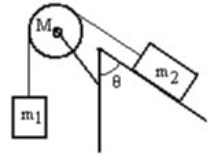
A) 0.00 m/s2
B) 1.20 m/s2
C) 1.80 m/s2
D) 2.20 m/s2
E) 2.80 m/s2

A) 0.00 m/s2
B) 1.20 m/s2
C) 1.80 m/s2
D) 2.20 m/s2
E) 2.80 m/s2

Unlock Deck
Unlock for access to all 91 flashcards in this deck.
Unlock Deck
k this deck
42
A mass m1 is connected by a light string that passes over a pulley of mass M to a mass m2 as shown in the figure. Both masses move vertically and there is no slippage between the string and the pulley. The pulley has a radius of 20.0 cm and a moment of inertia of ½ MR2. If m1 is 3.00 kg, m2 is 6.00 kg and M is 4.00 kg, then what is the tension in the string that is attached to mass m2? 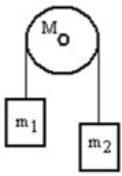
A) 33.6 N
B) 42.8 N
C) 53.6 N
D) 63.4 N
E) 75.5 N

A) 33.6 N
B) 42.8 N
C) 53.6 N
D) 63.4 N
E) 75.5 N

Unlock Deck
Unlock for access to all 91 flashcards in this deck.
Unlock Deck
k this deck
43
A mass m1 is connected by a light string that passes over a pulley of mass M to a mass m2 sliding on a frictionless horizontal surface as shown in the figure. There is no slippage between the string and the pulley. The pulley has a radius of 25 cm and a moment of inertia of ½ MR2. If m1 is 4.00 kg, m2 is 2.00 kg, and M is 4.00 kg, then what is the downward acceleration of m1? 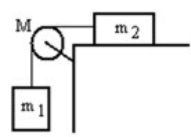
A) 4.9 m/s2
B) 4.5 m/s2
C) 4.1 m/s2
D) 3.9 m/s2
E) 3.7 m/s2

A) 4.9 m/s2
B) 4.5 m/s2
C) 4.1 m/s2
D) 3.9 m/s2
E) 3.7 m/s2

Unlock Deck
Unlock for access to all 91 flashcards in this deck.
Unlock Deck
k this deck
44
A mass m1 is connected by a light string that passes over a pulley of mass M to a mass m2 sliding on a frictionless incline as shown in the figure. There is no slippage between the string and the pulley. The pulley has a radius of 25.0 cm and a moment of inertia of ½ MR2. If m1 is 2.00 kg, m2 is 1.00 kg, M is 4.00 kg, and the angle is 60.0 degrees, then what is the acceleration of m1? 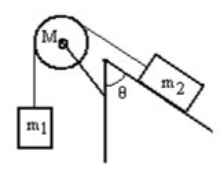
A) 3.98 m/s2 down
B) 3.27 m/s2 down
C) 3.15 m/s2 down
D) 2.94 m/s2 down
E) 1.64 m/s2 down

A) 3.98 m/s2 down
B) 3.27 m/s2 down
C) 3.15 m/s2 down
D) 2.94 m/s2 down
E) 1.64 m/s2 down

Unlock Deck
Unlock for access to all 91 flashcards in this deck.
Unlock Deck
k this deck
45
A 4.00 kg hollow sphere of radius 5.00 cm starts from rest and rolls without slipping down a 30.0 degree incline. The acceleration of the center of mass of the hollow sphere is
A) 2.00 m/s2.
B) 2.22 m/s2.
C) 2.50 m/s2.
D) 2.64 m/s2.
E) 2.94 m/s2.
A) 2.00 m/s2.
B) 2.22 m/s2.
C) 2.50 m/s2.
D) 2.64 m/s2.
E) 2.94 m/s2.

Unlock Deck
Unlock for access to all 91 flashcards in this deck.
Unlock Deck
k this deck
46
A mass m1 is connected by a light string that passes over a pulley of mass M to a mass m2 sliding on a frictionless horizontal surface as shown in the figure. There is no slippage between the string and the pulley. The pulley has a radius of 25.0 cm and a moment of inertia of ½ MR2. If m1 is 1.00 kg, m2 is 2.00 kg, and M is 4.00 kg, then what is the tension in the string attached to m2? 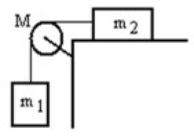
A) 3.92 m/s2
B) 3.65 m/s2
C) 3.23 m/s2
D) 3.02 m/s2
E) 2.98 m/s2

A) 3.92 m/s2
B) 3.65 m/s2
C) 3.23 m/s2
D) 3.02 m/s2
E) 2.98 m/s2

Unlock Deck
Unlock for access to all 91 flashcards in this deck.
Unlock Deck
k this deck
47
A mass m1 is connected by a light string that passes over a pulley of mass M to a mass m2 as shown in the figure. Both masses move vertically and there is no slippage between the string and the pulley. The pulley has a radius of 30.0 cm and a moment of inertia of MR2. If m1 is 4.00 kg, m2 is 3.00 kg and M is 6.00 kg, then what is the magnitude of the acceleration of the masses? 
A) 0.695 m/s2
B) 0.703 m/s2
C) 0.731 m/s2
D) 0.754 m/s2
E) 0.805 m/s2

A) 0.695 m/s2
B) 0.703 m/s2
C) 0.731 m/s2
D) 0.754 m/s2
E) 0.805 m/s2

Unlock Deck
Unlock for access to all 91 flashcards in this deck.
Unlock Deck
k this deck
48
A mass m1 is connected by a light string that passes over a pulley of mass M to a mass m2 sliding on a frictionless horizontal surface as shown in the figure. There is no slippage between the string and the pulley. The pulley has a radius of 25.0 cm and a moment of inertia of ½ MR2. If m1 is 1.00 kg, m2 is 2.00 kg, and M is 4.00 kg, then what is the downward acceleration of m1? 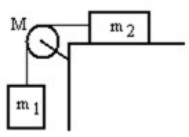
A) 1.55 m/s2
B) 1.96 m/s2
C) 2.06 m/s2
D) 2.33 m/s2
E) 2.72 m/s2

A) 1.55 m/s2
B) 1.96 m/s2
C) 2.06 m/s2
D) 2.33 m/s2
E) 2.72 m/s2

Unlock Deck
Unlock for access to all 91 flashcards in this deck.
Unlock Deck
k this deck
49
A 20.0 kg hollow cylinder (I = MR2) has a diameter of 50.0 cm. The cylinder is rolling down a hill with a velocity of 5.00 m/s. The rotational kinetic energy of the rolling cylinder is
A) 225 J.
B) 200 J.
C) 175 J.
D) 150 J.
E) 250 J.
A) 225 J.
B) 200 J.
C) 175 J.
D) 150 J.
E) 250 J.

Unlock Deck
Unlock for access to all 91 flashcards in this deck.
Unlock Deck
k this deck
50
A mass m1 is connected by a light string that passes over a pulley of mass M to a mass m2 sliding on a frictionless horizontal surface as shown in the figure. There is no slippage between the string and the pulley. The pulley has a radius of 25.0 cm and a moment of inertia of ½ MR2. If m1 is 4.00 kg, m2 is 4.00 kg, and M is 4.00 kg, then what is the tension in the string attached to m1? 
A) 35.6 N
B) 32.7 N
C) 31.0 N
D) 29.0 N
E) 23.5 N

A) 35.6 N
B) 32.7 N
C) 31.0 N
D) 29.0 N
E) 23.5 N

Unlock Deck
Unlock for access to all 91 flashcards in this deck.
Unlock Deck
k this deck
51
A 4.00 kg solid sphere (I = 2/5 MR2) is spinning with an angular velocity of 23.0 rad/s. The diameter of the sphere is 20.0 cm. The rotational kinetic energy of the spinning sphere is
A) 3.02 J.
B) 3.52 J.
C) 3.75 J.
D) 4.02 J.
E) 4.23 J.
A) 3.02 J.
B) 3.52 J.
C) 3.75 J.
D) 4.02 J.
E) 4.23 J.

Unlock Deck
Unlock for access to all 91 flashcards in this deck.
Unlock Deck
k this deck
52
A mass m1 is connected by a light string that passes over a pulley of mass M to a mass m2 sliding on a frictionless incline as shown in the figure. There is no slippage between the string and the pulley. The pulley has a radius of 30.0 cm and a moment of inertia of MR2. If m1 is 4.00 kg, m2 is 4.00 kg, M is 4.00 kg, and the angle is 70.0 degrees, then what is the acceleration of m1? 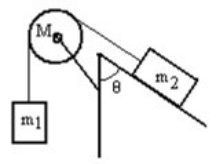
A) 3.10 m/s2 down
B) 2.89 m/s2 down
C) 2.43 m/s2 down
D) 2.15 m/s2 down
E) 1.49 m/s2 down

A) 3.10 m/s2 down
B) 2.89 m/s2 down
C) 2.43 m/s2 down
D) 2.15 m/s2 down
E) 1.49 m/s2 down

Unlock Deck
Unlock for access to all 91 flashcards in this deck.
Unlock Deck
k this deck
53
A mass m1 is connected by a light string that passes over a pulley of mass M to a mass m2 sliding on a frictionless horizontal surface as shown in the figure. There is no slippage between the string and the pulley. The pulley has a radius of 25.0 cm and a moment of inertia of ½ MR2. If m1 is 4.00 kg, m2 is 4.00 kg, and M is 4.00 kg, then what is the tension in the string attached to m2? 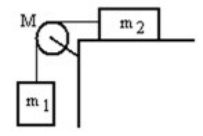
A) 10.4 N
B) 12.6 N
C) 15.7 N
D) 17.6 N
E) 19.8 N

A) 10.4 N
B) 12.6 N
C) 15.7 N
D) 17.6 N
E) 19.8 N

Unlock Deck
Unlock for access to all 91 flashcards in this deck.
Unlock Deck
k this deck
54
A mass m1 is connected by a light string that passes over a pulley of mass M to a mass m2 as shown in the figure. Both masses move vertically and there is no slippage between the string and the pulley. The pulley has a radius of 30.0 cm and a moment of inertia of MR2. If m1 is 4.00 kg, m2 is 3.00 kg and M is 6.00 kg, then what is the tension in the string that is attached to m2? 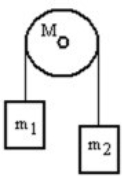
A) 20.7 N
B) 25.5 N
C) 31.7 N
D) 35.2 N
E) 41.3 N

A) 20.7 N
B) 25.5 N
C) 31.7 N
D) 35.2 N
E) 41.3 N

Unlock Deck
Unlock for access to all 91 flashcards in this deck.
Unlock Deck
k this deck
55
A mass m1 is connected by a light string that passes over a pulley of mass M to a mass m2 as shown in the figure. Both masses move vertically and there is no slippage between the string and the pulley. The pulley has a radius of 20.0 cm and a moment of inertia of ½ MR2. If m1 is 3.00 kg, m2 is 6.00 kg and M is 4.00 kg, then what is the tension in the string that is attached to mass m1? 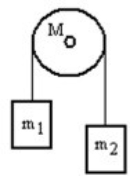
A) 20.8 N
B) 27.4 N
C) 30.2 N
D) 37.4 N
E) 43.5 N

A) 20.8 N
B) 27.4 N
C) 30.2 N
D) 37.4 N
E) 43.5 N

Unlock Deck
Unlock for access to all 91 flashcards in this deck.
Unlock Deck
k this deck
56
A mass m1 is connected by a light string that passes over a pulley of mass M to a mass m2 as shown in the figure. Both masses move vertically and there is no slippage between the string and the pulley. The pulley has a radius of 30.0 cm and a moment of inertia of MR2. If m1 is 4.00 kg, m2 is 3.00 kg and M is 6.00 kg, then what is the tension in the string that is attached to m1? 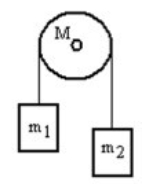
A) 36.2 N
B) 44.6 N
C) 58.2 N
D) 60.6 N
E) 74.5 N

A) 36.2 N
B) 44.6 N
C) 58.2 N
D) 60.6 N
E) 74.5 N

Unlock Deck
Unlock for access to all 91 flashcards in this deck.
Unlock Deck
k this deck
57
A 4.00 kg hollow sphere (I = 2/3 MR2) is spinning with an angular velocity of 10.0 rad/s. The diameter of the sphere is 20.0 cm. The rotational kinetic energy of the spinning sphere is
A) 1.75 J.
B) 1.50 J.
C) 1.33 J.
D) 0.90 J.
E) 0.75 J.
A) 1.75 J.
B) 1.50 J.
C) 1.33 J.
D) 0.90 J.
E) 0.75 J.

Unlock Deck
Unlock for access to all 91 flashcards in this deck.
Unlock Deck
k this deck
58
A mass m1 is connected by a light string that passes over a pulley of mass M to a mass m2 sliding on a frictionless horizontal surface as shown in the figure. There is no slippage between the string and the pulley. The pulley has a radius of 25.0 cm and a moment of inertia of ½ MR2. If m1 is 1.00 kg, m2 is 2.00 kg, and M is 4.00 kg, then what is the tension in the string attached to m1? 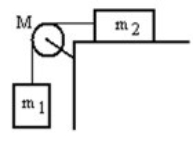
A) 6.83 N
B) 7.03 N
C) 7.84 N
D) 8.02 N
E) 8.33 N

A) 6.83 N
B) 7.03 N
C) 7.84 N
D) 8.02 N
E) 8.33 N

Unlock Deck
Unlock for access to all 91 flashcards in this deck.
Unlock Deck
k this deck
59
A mass m1 is connected by a light string that passes over a pulley of mass M to a mass m2 as shown in the figure. Both masses move vertically and there is no slippage between the string and the pulley. The pulley has a radius of 20.0 cm and a moment of inertia of ½ MR2. If m1 is 3.00 kg, m2 is 6.00 kg and M is 4.00 kg, then what is the magnitude of the acceleration of the masses? 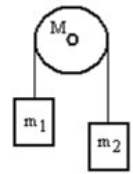
A) 5.05 m/s2
B) 4.75 m/s2
C) 4.05 m/s2
D) 3.44 m/s2
E) 2.67 m/s2

A) 5.05 m/s2
B) 4.75 m/s2
C) 4.05 m/s2
D) 3.44 m/s2
E) 2.67 m/s2

Unlock Deck
Unlock for access to all 91 flashcards in this deck.
Unlock Deck
k this deck
60
A mass m1 is connected by a light string that passes over a pulley of mass M to a mass m2 sliding on a frictionless horizontal surface as shown in the figure. There is no slippage between the string and the pulley. The pulley has a radius of 25.0 cm and a moment of inertia of ½ MR2. If m1 is 4.00 kg, m2 is 4.00 kg, and M is 4.00 kg, then what is the downward acceleration of m1? 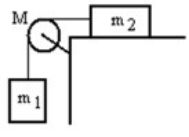
A) 4.42 m/s2
B) 3.92 m/s2
C) 3.42 m/s2
D) 3.04 m/s2
E) 2.96 m/s2

A) 4.42 m/s2
B) 3.92 m/s2
C) 3.42 m/s2
D) 3.04 m/s2
E) 2.96 m/s2

Unlock Deck
Unlock for access to all 91 flashcards in this deck.
Unlock Deck
k this deck
61
A grinding wheel has a mass of 250 kg and moment of inertia of 500 kg m2. A torque of 100 N•m is applied to the grinding wheel. If the wheel starts from rest, what is the angular momentum of the wheel after 5.0 seconds?
A) 650 kg m2/s
B) 500 kg m2/s
C) 450 kg m2/s
D) 300 kg m2/s
E) 250 kg m2/s
A) 650 kg m2/s
B) 500 kg m2/s
C) 450 kg m2/s
D) 300 kg m2/s
E) 250 kg m2/s

Unlock Deck
Unlock for access to all 91 flashcards in this deck.
Unlock Deck
k this deck
62
A 4.00 kg solid sphere of radius 5.00 cm starts from rest and rolls without slipping down a 30.0 degree incline. If the length of the incline is 50.0 cm, then the velocity of the center of mass of the solid sphere at the bottom of the incline is
A) 1.69 m/s.
B) 1.87 m/s.
C) 2.33 m/s.
D) 2.75 m/s.
E) 3.22 m/s.
A) 1.69 m/s.
B) 1.87 m/s.
C) 2.33 m/s.
D) 2.75 m/s.
E) 3.22 m/s.

Unlock Deck
Unlock for access to all 91 flashcards in this deck.
Unlock Deck
k this deck
63
A 1.5 m long, 0.75 kg dowel is pivoted about the end so that it is a pendulum of sorts - it can freely swing in a vertical plane. At the other end of the dowel is a brass weight having mass 1.5 kg. (The center of the brass weight is 1.5 m from the pivot point.) When the rod is positioned in its swing such that its angle with the vertical is 22.5 degrees, what is the net torque on the rod about the pivot?
A) 11 N·m
B) 28 N·m
C) 10.5 N·m
D) 25 N·m
A) 11 N·m
B) 28 N·m
C) 10.5 N·m
D) 25 N·m

Unlock Deck
Unlock for access to all 91 flashcards in this deck.
Unlock Deck
k this deck
64
A 4.00 kg solid sphere of radius 5.00 cm starts from rest and rolls without slipping down a 30.0 degree incline. The acceleration of the center of mass of the solid sphere is
A) 1.50 m/s2.
B) 2.00 m/s2.
C) 2.50 m/s2.
D) 3.00 m/s2.
E) 3.50 m/s2.
A) 1.50 m/s2.
B) 2.00 m/s2.
C) 2.50 m/s2.
D) 3.00 m/s2.
E) 3.50 m/s2.

Unlock Deck
Unlock for access to all 91 flashcards in this deck.
Unlock Deck
k this deck
65
A piston in an internal combustion engine applies torque during 150° of each full rotation of the crankshaft to which it is connected. Suppose an 8-cylinder engine (8 such pistons) is running with its crankshaft turning at 2500 rpm and produces 410 J of work each second. What is the average torque applied to the crank shaft by one of the engine's eight pistons?
A) 3.8 N·m
B) 1.6 N·m
C) 0.47 N·m
D) 0.20 N·m
A) 3.8 N·m
B) 1.6 N·m
C) 0.47 N·m
D) 0.20 N·m

Unlock Deck
Unlock for access to all 91 flashcards in this deck.
Unlock Deck
k this deck
66
A 10 kg solid cylinder (I = 1/2 MR2) with a radius of 30.0 cm is rotating about a vertical axis through its center. If the angular momentum is increasing at the rate of 25.0 kg m2/s2, then what is the angular acceleration?
A) 75.3 rad/s2
B) 65.9 rad/s2
C) 55.6 rad/s2
D) 40.5 rad/s2
E) 35.2 rad/s2
A) 75.3 rad/s2
B) 65.9 rad/s2
C) 55.6 rad/s2
D) 40.5 rad/s2
E) 35.2 rad/s2

Unlock Deck
Unlock for access to all 91 flashcards in this deck.
Unlock Deck
k this deck
67
A 4.00 kg hollow sphere of radius 5.00 cm starts from rest and rolls without slipping down a 30.0 degree incline. If the length of the incline is 50.0 cm, then the velocity of the center of mass of the hollow sphere at the bottom of the incline is
A) 1.28 m/s.
B) 1.44 m/s.
C) 1.65 m/s.
D) 1.71 m/s.
E) 1.98 m/s.
A) 1.28 m/s.
B) 1.44 m/s.
C) 1.65 m/s.
D) 1.71 m/s.
E) 1.98 m/s.

Unlock Deck
Unlock for access to all 91 flashcards in this deck.
Unlock Deck
k this deck
68
A 1.5m long dowel is pivoted about the end so that it is a pendulum of sorts - it can freely swing in a vertical plane. At the other end of the dowel is a brass weight having mass 1.5 kg. (The center of the brass weight is 1.5 m from the pivot point. When the rod is positioned in its swing such that its angle with the vertical is 22.5 degrees, what is the torque on the rod about the pivot due to the presence of the brass weight?
A) 8.4 N·m
B) 22 N·m
C) 20 N·m
D) 9.1 N·m
A) 8.4 N·m
B) 22 N·m
C) 20 N·m
D) 9.1 N·m

Unlock Deck
Unlock for access to all 91 flashcards in this deck.
Unlock Deck
k this deck
69
A fire fighter tightens the nut on the top of a fire hydrant using a large wrench. If she applies a force of 250 N perpendicular to the wrench, at a point 0.75 m from the axis of rotation of the nut, how much work does she do on the nut as she rotates it through 45°?
A) 190 J
B) 150 J
C) 290 J
D) 130 J
A) 190 J
B) 150 J
C) 290 J
D) 130 J

Unlock Deck
Unlock for access to all 91 flashcards in this deck.
Unlock Deck
k this deck
70
A 100 kg solid spherical rock (I = 2/5 MR2) has a diameter of 50.0 cm. The rock is rolling down a hill with a velocity of 5.00 m/s. The total kinetic energy (angular + translational) of the rolling rock is
A) 1,750 J.
B) 2,000 J.
C) 2,250 J.
D) 2,670 J.
E) 2,900 J.
A) 1,750 J.
B) 2,000 J.
C) 2,250 J.
D) 2,670 J.
E) 2,900 J.

Unlock Deck
Unlock for access to all 91 flashcards in this deck.
Unlock Deck
k this deck
71
A 2.00 kg solid sphere (I = 2/5 MR2) with a diameter of 50.0 cm is rotating at an angular velocity of 5.0 rad/s. The angular momentum of the rotating sphere is
A) 0.55 kg m2/s.
B) 0.48 kg m2/s.
C) 0.37 kg m2/s.
D) 0.25 kg m2/s.
E) 0.20 kg m2/s.
A) 0.55 kg m2/s.
B) 0.48 kg m2/s.
C) 0.37 kg m2/s.
D) 0.25 kg m2/s.
E) 0.20 kg m2/s.

Unlock Deck
Unlock for access to all 91 flashcards in this deck.
Unlock Deck
k this deck
72
An ice dancer with her arms stretched out starts into a spin with an angular velocity of 1.00 rad/s. Her moment of inertia with her arms stretched out is 2.48 kg m2. What is the increase in her rotational kinetic energy when she pulls in her arms to make her moment of inertia 1.40 kg m2?
A) 0.957 J
B) 0.902 J
C) 0.870 J
D) 0.750 J
E) 0.690 J
A) 0.957 J
B) 0.902 J
C) 0.870 J
D) 0.750 J
E) 0.690 J

Unlock Deck
Unlock for access to all 91 flashcards in this deck.
Unlock Deck
k this deck
73
An ice dancer with her arms stretched out starts into a spin with an angular velocity of 1.00 rad/s. Her moment of inertia with her arms stretched out is 2.48 kg m2. What is her angular velocity when she pulls in her arms to make her moment of inertia 1.40 kg m2?
A) 2.67 rad/s
B) 2.45 rad/s
C) 2.03 rad/s
D) 1.90 rad/s
E) 1.77 rad/s
A) 2.67 rad/s
B) 2.45 rad/s
C) 2.03 rad/s
D) 1.90 rad/s
E) 1.77 rad/s

Unlock Deck
Unlock for access to all 91 flashcards in this deck.
Unlock Deck
k this deck
74
A 4.00 kg hollow cylinder of radius 5.00 cm starts from rest and rolls without slipping down a 30.0 degree incline. The acceleration of the center of mass of the cylinder is
A) 2.45 m/s2.
B) 2.98 m/s2.
C) 3.35 m/s2.
D) 3.98 m/s2.
E) 4.05 m/s2.
A) 2.45 m/s2.
B) 2.98 m/s2.
C) 3.35 m/s2.
D) 3.98 m/s2.
E) 4.05 m/s2.

Unlock Deck
Unlock for access to all 91 flashcards in this deck.
Unlock Deck
k this deck
75
A 4.00 kg hollow cylinder of radius 5.00 cm starts from rest and rolls without slipping down a 30.0 degree incline. If the length of the incline is 50.0 cm, then the velocity of the center of mass of the cylinder at the bottom of the incline is
A) 1.35 m/s.
B) 1.82 m/s.
C) 1.57 m/s.
D) 2.55 m/s.
E) 3.02 m/s.
A) 1.35 m/s.
B) 1.82 m/s.
C) 1.57 m/s.
D) 2.55 m/s.
E) 3.02 m/s.

Unlock Deck
Unlock for access to all 91 flashcards in this deck.
Unlock Deck
k this deck
76
A pirate demands that his 75 kg prisoner "walk the plank". The prisoner walks out on an 8.0 m long, 50 kg horizontal board that juts out from the side of the pirate ship. If he walks out and stands 7.5 m from the place where the board is connected to the ship's side, what is the net torque applied to the board?
A) 5500 N·m
B) 7500 N·m
C) 0 N·m
D) 2000 N·m
E) Cannot determine
A) 5500 N·m
B) 7500 N·m
C) 0 N·m
D) 2000 N·m
E) Cannot determine

Unlock Deck
Unlock for access to all 91 flashcards in this deck.
Unlock Deck
k this deck
77
A 3.00 kg hollow sphere of radius 5.00 cm starts from rest and rolls without slipping down a 15.0 degree incline. If the length of the incline is 100 cm, then the velocity of the center of mass of the hollow sphere at the bottom of the incline is
A) 3.02 m/s.
B) 2.59 m/s.
C) 2.37 m/s.
D) 2.02 m/s.
E) 1.74 m/s.
A) 3.02 m/s.
B) 2.59 m/s.
C) 2.37 m/s.
D) 2.02 m/s.
E) 1.74 m/s.

Unlock Deck
Unlock for access to all 91 flashcards in this deck.
Unlock Deck
k this deck
78
A 10 kg solid cylinder (I = 1/2 MR2) with a radius of 30.0 cm is rotating about a vertical axis through its center. If the angular momentum is increasing at the rate of 25 kg m2/s2, then what is the torque?
A) 70 N·m
B) 45 N·m
C) 37 N·m
D) 25 N·m
E) 12 N·m
A) 70 N·m
B) 45 N·m
C) 37 N·m
D) 25 N·m
E) 12 N·m

Unlock Deck
Unlock for access to all 91 flashcards in this deck.
Unlock Deck
k this deck
79
A pole-vaulter holds out a 5.5 kg, 4.75 m long pole horizontally in front of him. Assuming the pole is uniform in construction, and that he holds the pole with one hand at the very end, and one hand 0.75 m from the end, what is the torque applied by the gravitational force to the pole?
A) 40 N
B) 88 N
C) Not enough information is given
D) 128 N
A) 40 N
B) 88 N
C) Not enough information is given
D) 128 N

Unlock Deck
Unlock for access to all 91 flashcards in this deck.
Unlock Deck
k this deck
80
A 2.00 kg hollow sphere of radius 6.00 cm starts from rest and rolls without slipping down a 10.0 degree incline. If the length of the incline is 50.0 cm, then the velocity of the center of mass of the hollow sphere at the bottom of the incline is
A) 1.51 m/s.
B) 1.47 m/s.
C) 1.22 m/s.
D) 1.01 m/s.
E) 1.95 m/s.
A) 1.51 m/s.
B) 1.47 m/s.
C) 1.22 m/s.
D) 1.01 m/s.
E) 1.95 m/s.

Unlock Deck
Unlock for access to all 91 flashcards in this deck.
Unlock Deck
k this deck



